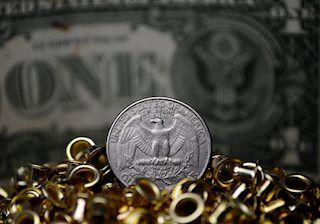US Dollar strong as markets turn their focs to September's Retail Sales
|
- US Dollar proves strong as markets are pricing in a Trump victory in November.
- Fed easing expectations: 150 bps of total easing seen over the next 12 months.
- Retail Sales on Thursday will be closely watched.
The US Dollar Index (DXY), which measures the value of the USD against a basket of six others, continues rising as financial markets are doubling down on a Donald Trump win in the US presidential election. This is mainly due to Trumps’s plans on several sectors of the economy of deregulating according to IG Bank’s analyst. The DXY has broken above key resistance and is on its way to 104.00.
With the US economy showing mixed signs, Federal Reserve (Fed) officials remain cautious, signaling that the pace of the easing will rely on incoming data. In the meantime, political jitters seem to be benefiting the USD ahead of November’s election.
Daily digest market movers: US Dollar adds more ground on quiet Wednesday
- The US economic calendar showed no highlights on Wednesday as markets wait for Thursday’s Retail Sales figures.
- In case those figures come in strong, it could give the USD another boost. As for now, markets are expecting a slight monthly expansion.
- Fed officials Daly and Bostic remain cautious, suggesting only one or two rate cuts this year.
- Market expectations for Fed easing have slightly decreased, with two cuts by year-end no longer fully priced in but still remaining high above 80%.
DXY technical outlook: DXY pierces through key levels, correction looms
Technical analysis for the DXY index indicates continued momentum among indicators with some flashing overbought signals. The index has broken above the crucial 100-day Simple Moving Average (SMA), with the next major resistance at the 200-day SMA at 103.80. While buyers are pushing for an optimistic outlook, a potential correction may occur before the next upswing.
Supports are found at 103.00, 102.50 and 103.00, while resistances lie at 103.30, 103.50 and 104.00.
Central banks FAQs
Central Banks have a key mandate which is making sure that there is price stability in a country or region. Economies are constantly facing inflation or deflation when prices for certain goods and services are fluctuating. Constant rising prices for the same goods means inflation, constant lowered prices for the same goods means deflation. It is the task of the central bank to keep the demand in line by tweaking its policy rate. For the biggest central banks like the US Federal Reserve (Fed), the European Central Bank (ECB) or the Bank of England (BoE), the mandate is to keep inflation close to 2%.
A central bank has one important tool at its disposal to get inflation higher or lower, and that is by tweaking its benchmark policy rate, commonly known as interest rate. On pre-communicated moments, the central bank will issue a statement with its policy rate and provide additional reasoning on why it is either remaining or changing (cutting or hiking) it. Local banks will adjust their savings and lending rates accordingly, which in turn will make it either harder or easier for people to earn on their savings or for companies to take out loans and make investments in their businesses. When the central bank hikes interest rates substantially, this is called monetary tightening. When it is cutting its benchmark rate, it is called monetary easing.
A central bank is often politically independent. Members of the central bank policy board are passing through a series of panels and hearings before being appointed to a policy board seat. Each member in that board often has a certain conviction on how the central bank should control inflation and the subsequent monetary policy. Members that want a very loose monetary policy, with low rates and cheap lending, to boost the economy substantially while being content to see inflation slightly above 2%, are called ‘doves’. Members that rather want to see higher rates to reward savings and want to keep a lit on inflation at all time are called ‘hawks’ and will not rest until inflation is at or just below 2%.
Normally, there is a chairman or president who leads each meeting, needs to create a consensus between the hawks or doves and has his or her final say when it would come down to a vote split to avoid a 50-50 tie on whether the current policy should be adjusted. The chairman will deliver speeches which often can be followed live, where the current monetary stance and outlook is being communicated. A central bank will try to push forward its monetary policy without triggering violent swings in rates, equities, or its currency. All members of the central bank will channel their stance toward the markets in advance of a policy meeting event. A few days before a policy meeting takes place until the new policy has been communicated, members are forbidden to talk publicly. This is called the blackout period.
Information on these pages contains forward-looking statements that involve risks and uncertainties. Markets and instruments profiled on this page are for informational purposes only and should not in any way come across as a recommendation to buy or sell in these assets. You should do your own thorough research before making any investment decisions. FXStreet does not in any way guarantee that this information is free from mistakes, errors, or material misstatements. It also does not guarantee that this information is of a timely nature. Investing in Open Markets involves a great deal of risk, including the loss of all or a portion of your investment, as well as emotional distress. All risks, losses and costs associated with investing, including total loss of principal, are your responsibility. The views and opinions expressed in this article are those of the authors and do not necessarily reflect the official policy or position of FXStreet nor its advertisers.